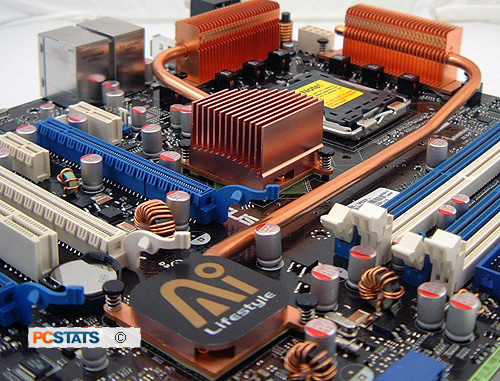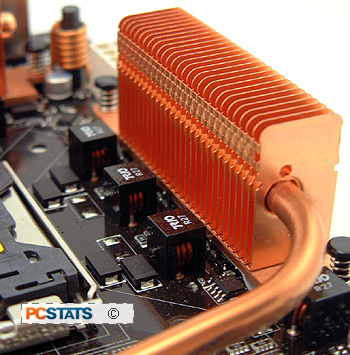The Asus P5N32-E SLI Plus motherboard has two copper heat pipes snaking
between its slots and connectors, connecting low profile passive chipset heatsinks
to two sets of copper fins situated around the LGA775 CPU
socket.
The nVIDIA nForce 650i SLI Intel Edition chipset generates
a lot of heat and thus requires more cooling than some previous nForce models
did. The nForce 570i SLI MCP (southbridge) has a finless copper block heatsink
mounted to it, with a heatpipe that connects it to a 28 fin copper heatsink set by
the CPU socket. The nForce 650i SLI Intel Edition SPP Northbridge has a
similar cooling arrangement, although the heatsink directly on top of this chipset
is passively cools as well.

In both cases, the heat from the chipsets is conducted to a
small copper fin heatsink resting on top of the boards' MOSFETs. These two
finned heatsinks work off the exhaust airflow from the CPU fan, which blows over
then just enough to keep the thermal environment in check.

The small
finned copper heatsinks on top of the MOSFETs require active cooling if the
processor is cooled with a passive heatsink, water cooling system or phase
change cooling. Unlike with previous motherboards, Asus does not include any
squirrel cage fans with the P5N32-E SLI Plus, so you'll need to point a fan in
the CPU socket's direction for those situations where CPU heatsink fan exhaust
is not present.
The nVIDIA
nForce 650i SLI Intel Edition chipset gets hot under the collar, but in PCSTATS
experience the copper Asus cooling system does a good job dealing with it
silently. Up next, a quick look at some of the highlights of the Asus P5N32-E
SLI Plus motherboard...
